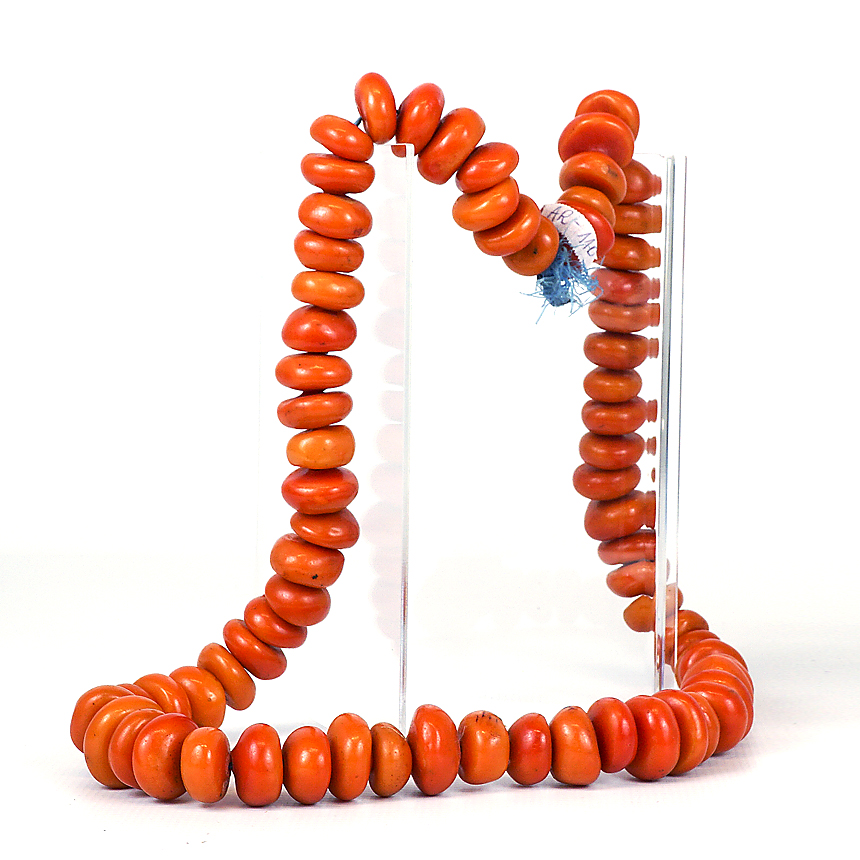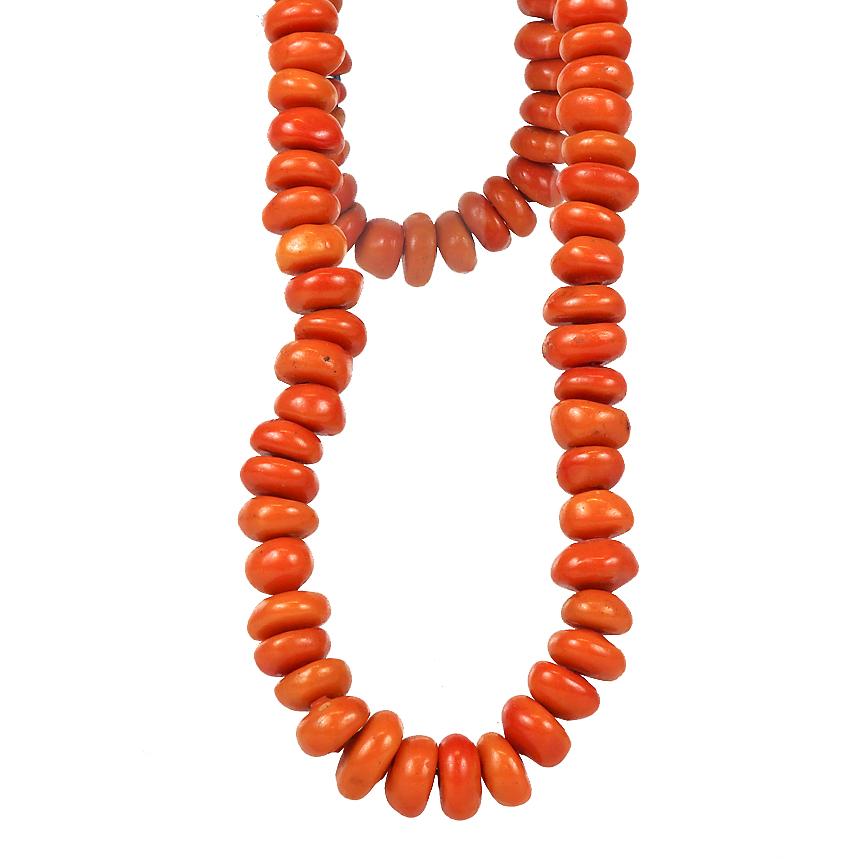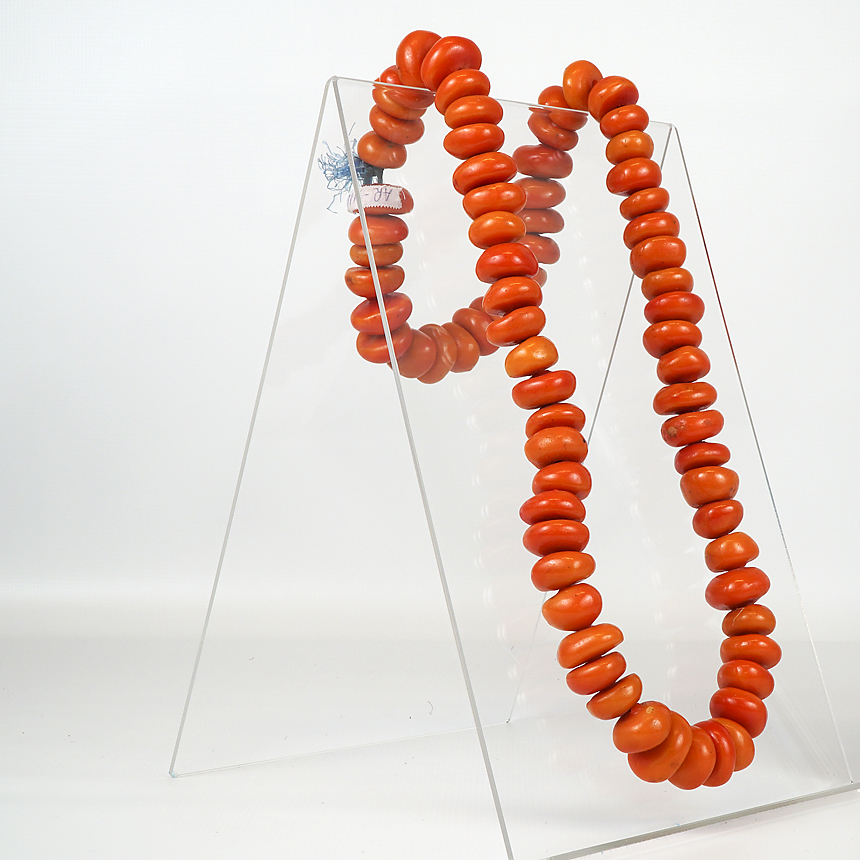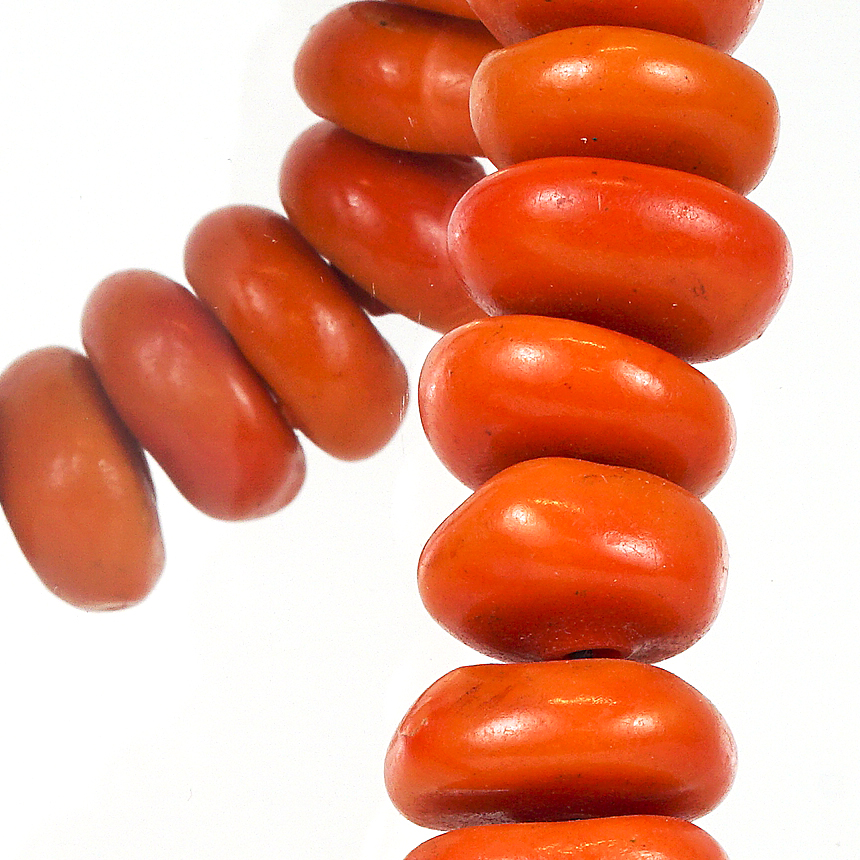Lubane Beads – MŻo/A/4003
Origin: Islamic Republic of Mauritania
Dating: 2nd half of 20th century
The string of large cylindrical beads, dark orange in color, is made of amber with a heavily matted surface or of synthetic phenolic resin. But where does our insecurity come from?
It is difficult to distinguish natural amber from synthetic amber with the naked eye. It would seem that real amber should be translucent or non-uniform in color, in shades of orange and brown. Meanwhile, there are about 60 types of amber known in the world, which differ in color or degree of transparency, and which depends on the time and place of origin and the type of tree from which the resin that formed it came. Amber can be subjected to various types of treatment (e.g. heat or pressure), so it is possible to interfere with its structure and freely modify its size, color, transparency, and hardness. Therefore, real (organic) amber does not necessarily mean natural (unmodified) amber. However, there are several ways to distinguish real amber from its cheaper alternative.
The first is to use the electrostatic phenomenon - amber rubbed against a natural material (e.g. cotton fabric) will start to attract small pieces of paper, wood shavings, or dust. The first who discovered this relationship in the 6th century BCE was Thales of Miletus, while the ancient Greek term ήλεκτρον (ēlektron) - gave rise to the name of electricity - the phenomenon related to the interaction of bodies containing an electric charge.
Another way is the so-called brine method. It consists in immersing amber in a vessel filled with water in which a large amount of salt has been dissolved. While products made of synthetic mass sink to the bottom, real amber will float on the surface of the water.
The other methods of checking the authenticity of amber are invasive. One of them is scratching amber with a sharp tool. If it is natural, small crumbs will form on its surface. Making a groove in the synthetic material, in turn, creates spiral streams. We can also set amber on fire - it then gives off a pleasant, resinous smell. Touching it with the tip of the glowing needle will cause it to sink inside, but it will be possible to remove it without any problems. In the case of "amber" made modernly of young resin, delicate threads of dissolved resin mass should stretch behind the needle.
Nevertheless, the wide range of modern techniques and access to various types of materials make it more and more difficult to clearly state the authenticity of amber using "home way" methods. Then the only solution is professional testing using the method of infrared spectroscopy or ultraviolet rays.
The presented beads come from Mauritania and are made by local craftsmen, most often blacksmiths. They are most popular among the Moors (less often Tuaregs) from the area of Timbuktu (Mali), southern Morocco, Mauritania, and Senegal. Although today the amber ornament is willingly worn by various women, it was traditionally reserved only for noble ladies.
Bibiliography:
- A. Sado, Jak sprawdzić autentyczność bursztynu?, [w:] www.amber.com (artykuł dostępny na stronie sklepu jubilerskiego), link: https://www.amber.com.pl/aktualnosci/86-informacje/2721-jak-sprawdzic-autentycznosc-bursztynu [dostęp: 22.02.2022].
- „Z bursztynem dookoła świata”, [w:] mz.pan.pl (opis wystawy czasowej poświęconej wyrobom z bursztynu znajdujący się na stronie internetowej Polskiej Akademii Nauk Muzeum Ziemi w Warszawie), link: https://mz.pan.pl/pl/z-bursztynem-dookola-swiata/[dostęp: 22.02.2022].
- A. Frankowska – Gryza, Bursztyn naturalny, prasowany czy syntetyczny. Jak je odróżnić?, [w:] www.allegro.pl (artykuł dostępny na stronie portalu aukcyjnego Allegro), link: https://allegro.pl/artykul/bursztyn-naturalny-prasowany-czy-syntetyczny-jak-je-odroznic-5LkOWZ0qrT5#bursztyn-modyfikowany [dostęp: 27.02.2022].
- Informacje częściowo uzyskane także dzięki uprzejmości kolekcjonera, A. Rybińskiego.
----------------------------------------------------------------------------
The purchase is co-financed by the Ministry of Culture, National Heritage and Sport as part of the National Institute of Museums and Collections' own program "Expansion of museum collections".



